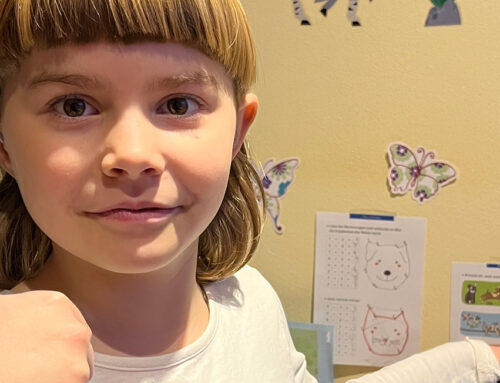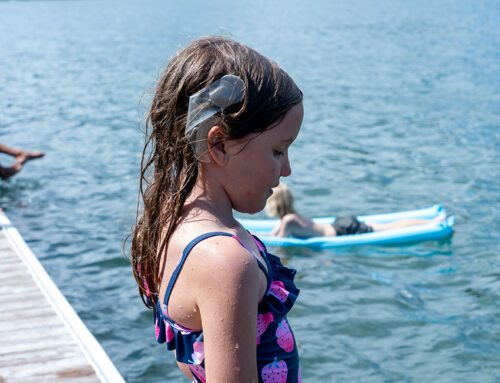A father describes how he chose a cochlear implant for his daughter
Dr Christian Schmidt MBA, a father of a child with a CI, describes which factors were decisive for him and his wife when choosing a CI system for their daughter.

“What did the doctor just say? What implant did he recommend? What did he mean by saying that parallel and serial are the same? Why doesn’t he take more time to explain this to us in detail?” When we received the diagnosis hearing loss for our daughter, we started the winding path through the jungle of completely new information, and we had to find our way out.
First, I want to say that MED-EL convinced us with their cochlear implants. These have 24 double contacts at 12 different longitudinal positions and a separate power source for each of these contacts. As the power sources are independent, this means that both serial and parallel coding can be processed. In future, we hope that research will produce more and more refined stimulation strategies – our daughter’s implant is in any case open to both system approaches.
What does serial or parallel mean?
The terms “serial” and “parallel” are familiar from the field of computers. The flow of current that transmits data and information can go either serially, one after the other via one contact, or simultaneously in parallel via several contacts. The latter can speed up the transmission of information: more information in less time. In the context of cochlear implants (CI for short) serial and parallel also refer to the flow of current; more precisely, to the way in which tiny current pulses stimulate the nerve fibers in the inner ear, or cochlea.
A CI system consists of an implant, which is not visible, and an audio-processor, which is worn externally. Audio processor can be either a single unit processor in the shape of a flat disc or a behind-the-ear processor (BTE) which looks almost like a normal hearing aid. The processor picks up sound waves with the microphone, then digitally processes this analog information and transmits it to the implant through a coil. The implant prepares the signals for the electrode contacts, where they are delivered as small pulses of electricity in the inner ear.
Depending on the manufacturer, there are 16 to 24 electrode contacts attached to the electrode array, the “electrode cable” which goes from the implant to the cochlea in the inner ear. This electrode is usually inserted via so-called round window into the scala tympani, the tympanic duct of the cochlea. Adjacent to the scala tympani is the organ of Corti, the actual organ of hearing. In the healthy ear, the organ of Corti supplies the auditory nerve with stimuli. With the CI, these stimuli are replaced by tiny current pulses from the electrode of the implant. In conventional CIs, this is done serially, one pulse after the other; but with the latest CI technologies, several pulses are sent parallelly.
The electrode: a comparison of different manufacturers
According to their brochure, the Austrian CI manufacturer MED-EL uses 24 electrode contacts, two more than the Australian Cochlear. Strictly speaking, MED-EL´s implants have 24 contacts at 12 different positions along the approximately 31-millimeter-long electrode array. These are referred to as double contacts, each with its own power lead. On the other hand, Cochlear has 22 contacts in different positions, but not all of them are used within one stimulation session.
Through different tests, it was determined that approximately 12 contacts provide an optimal distance between the individual stimulation points. For physical reasons, every current impulse, no matter how small, can be a subject to a certain among of dispersion. The resulting “current field” not only stimulates at the exact point of contact, but also stimulates cochlea more broadly. Therefore, more than 12 electrode contacts cannot bring any significant improvement.
How many sounds can I hear?
When rolled up, the tympanic duct where the CI electrode lies is around 31 mm long. Healthy inner ear has around 30 000 hair cells in the organ of Corti which are responsible for generation of the nerve impulses during hearing. With a CI, there is a maximum of 24 electrodes available on sometimes less than 31 millimeters. In comparison to 30 000 this may sound insufficient.
With the 30 000 hair cells, a healthy ear can differentiate between more than a thousand pitches. With a CI, more than 100. However, according to the respective marketing prospects, hearing “more” with a CI can be achieved with so-called “virtual contacts” which are created through serial or parallel technology.
More pitches through virtual electrodes
Experts speak of a virtual electrode when it does not exist physically as an electrode contact. It is created by superimposing the electrical fields of two neighboring contacts.
For example, let´s take a look at two neighboring contacts A and B: if “electric current” is delivered at point A the nerve fibers (or ganglion cells) will be stimulated in the area of the contact and the corresponding tone will be heard. If the point B is stimulated instead, the area around this contact will be stimulated and the corresponding tone will be heard. But, if we activate both contacts simultaneously, the electric field of both contacts will overlap. With the same distribution between the fields, a field maximum is formed approximately in the center between two contacts. Regarding the neural stimulation, a so-called virtual electrode is formed. If one contact is stimulated more than the other, then the maximum shifts in the direction of that contact. Again, this creates a new virtual electrode or a new tone.
This principle cannot be graded the same as in natural hearing. However, if you combine different pulse strengths on the real channels differently, you can derive several virtual electrodes between two contacts and create new audible tones.
Virtual channels – serial or parallel
In parallel stimulation, the current is applied simultaneously to two adjacent contacts. For an actual electrical connection, there must be a correspondingly large number of current sources.
In serial stimulation, the system of virtual electrodes is achieved by stimulating the neighboring contacts sequentially – one after the other. After that, a tone is simulated by a double pulse. Two pulses on neighboring contacts occur in quick succession, separated in microseconds.
You can think of this effect as being similar to the old movies or flipbooks, when our eye perceives the rapidly successive images as one moving picture.
How many channels do we need to hear?
The sequential stimulation method for CI involves the superimposition of fields in rapid succession. The current is first applied to contact A, which is then switched off again. Immediately afterwards, stimulation is applied to contact B. This way, a field maximum is generated in the middle of the two physically existing contacts, which in turn creates a virtual electrode – only with a slight time delay.
Extensive studies conducted on adult CI users showed that between 127 and 161 different pitches can be perceived in the serial manner. In the parallel approach, the number of pitches depends on the number of possible contact pairs and the number of levels of current pitches and the number of levels of current pitches. Research demonstrated up to 460 pitches: in practice, depending on the encoding strategy, a value of up to 250 pitches has been confirmed.
Benefits of parallel stimulation and further decision criteria
CI systems with parallel stimulation allow more and simultaneous “virtual channels”. They also enable encoding that uses the parallel system in the low to midrange and rely on serial system in the high-frequency range. This makes it possible to imitate natural hearing. The parallel current sources also give the system increased reliability with additional safety. In my opinion, the parallel stimulation capability is the most important differentiator between various cochlear implants.
The second important factor for my decision was the nature and length of the electrode. This length is also the answer to the question: “Why do some CI users hear voices like Mickey Mouse, while others hear relatively clearly?” Of course, there are also various other possible factors for a decision, but these come at the end of my personal ranking, for example features like Bluetooth connectivity or iPhone apps.
As we understand it, the manufacturer Cochlear still works with the serial stimulation and has 22 contacts on a shorter electrode with only one power supply. MED-EL has 24 double contacts at 12 different longitudinal positions on a longer electrode but provides a separate power supply for each of these contacts. And this also allows parallel stimulation.
So, we primarily chose a MED-EL CI because it is currently the only system with the possibility of parallel stimulation.






